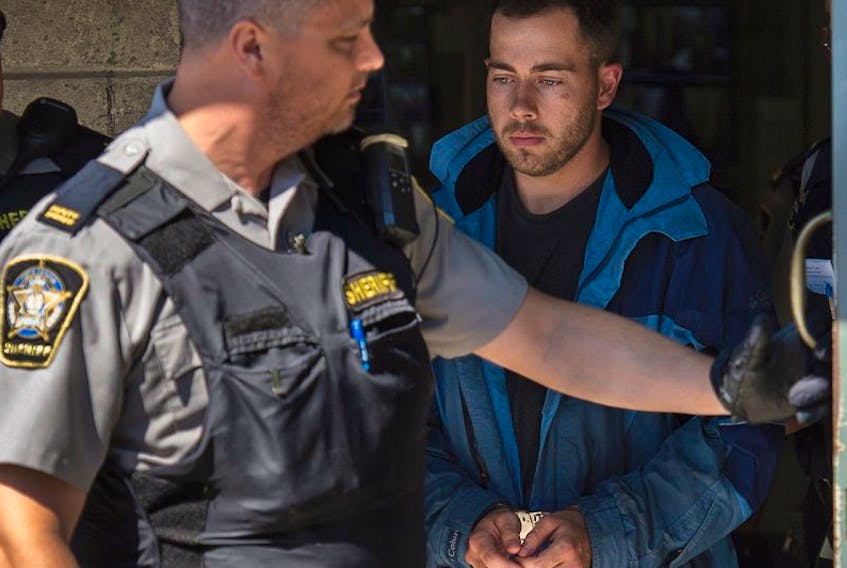UPDATE 12 p.m.: Christopher Keddy, a toxicology expert at the RCMP's National Forensic Services lab in Ottawa took the stand Wednesday morning. The lab examined vials of vitreous fluid from the eyes, as well as urine and blood samples. There were no drugs in Campbell's body, but alcohol was found, he said.
The alcohol readings were 214 milligrams of alcohol in 100 millilitres of vitreous fluid, 261 mg in 100 ml of urine and 169 mg of alcohol in 100 ml of blood. Keddy said that levels above 120-150 mg can mean impairment, but the body and brain can build up a tolerance to alcohol.
Eyewitnesses who saw Campbell at the Alehouse and as she left early on Sept. 11 noted that she was steady on her feet and able to both hail a cab and pay for it on her debit card. Keddy said this suggested "some aspect of control." He also said that it "clearly demonstrated some tolerance to the effects of alcohol. Alcohol tolerance "requires repeated exposure," which can be achieved over a period of time by regular Friday or Saturday night drinking, for example.
Keddy also said that if someone in Campbell's condition had physical control, then "a degree of mental awareness should also remain."
•••
Update: The murder trial for Christopher Garnier who is charged with second degree murder in the death of Catherine Campbell continued Wednesday.
Campbell was a Truro police officer who had grown up in Stellarton.
The first witness for the day was David Gregory Yeo. On Sept. 11, 2015 he lived in Hamilton Lane near Barrington Street. He woke up at 5:10 or 5:12 a.m. to make coffee, he told the court room.
He testified that he looked towards Barrington and observed a man struggling to pull a green bin across Barrington. He was "dragging it towards that tree line underneath the overpass," he said. The man he saw then returned. He was seen screaming, cursing, laughing and throwing the bin about.
"He was very peculiar, out of place," Yeo said.
Yeo described the man as wearing a light-coloured t-shirt and gym pants that were maybe grey.
The next witness to testify was Halifax Regional Police officer David Robertson. On the night of Sept. 15-16 he was plainclothes and helping to track a man identified as Garnier. He saw a white Ford drive past on Willet Street. In the early hours of Sept. 16 the vehicle was stopped. "My interaction with him was very, very brief." He helped to search Garnier and retrieved keys and a lighter.
Halifax Regional Police officer Kenneth Burton was also working in plainclothes that night and was in an unmarked car. He helped track a Ford Edge from Clayton Park towards North Street, Barrington and then back to Clayton Park. There, Garnier was arrested during a traffic stop in the early hours of Sept. 16. Police found items including a tarp, tape, yellow rope, a brown blanket, gloves and a backpack in the vehicle. Defence lawyer Joel Pink questioned whether the items were for Garnier's legitimate employment.
•••
Defence lawyer Joel Pink posed a hypothetical situation to the chief medical examiner for the Province of Nova Scotia as the murder trial for Christopher Garnier continued Tuesday in Halifax.
Garnier is charged with second-degree murder in the death of Catherine Campbell who worked as a police officer for the Truro police and had grown up in Stellarton.
Pink questioned whether the injuries that Catherine Campbell’s body showed could have been caused in a hypothetical situation of two people engaged in erotic asphyxiation known as “breathplay.”
He posed a hypothetical situation of a person called A going downtown, meeting person B at the Alehouse and returning to his friend's place where they continue. Back at the home, B asks A to be choked and mentions domination as a fantasy. She asks A to squeeze harder on the neck and she does not resist. However, B dies on the couch. A removes her body and drags it to the brush, causing injuries.
Dr. Matt Bowes, chief medical examiner, testified during the Crown’s examination that Campbell’s cause of death is strangulation and the manner of death was homicide.
Photographs of Campbell's body were shown to the court. Bowes attended the scene where her body was found. It was lying face down with her legs tucked in when found.
Campbell was identified via dental records. Her body was described as discoloured and subject to insect activity. She had a broken nose and black eyes as well as signs of bleeding in the whites of her eyes.
She also had abrasions on her neck and injuries in the vicinity of her voice box/Adam's apple. Bowes said the nose fracture happened "around or just before death.” Bowes noticed "a number of small abrasions are on the left side of her neck." There were also some on the right.
Bowes said that people being strangled can lose consciousness in seconds and death occurs in four minutes, give or take a minute. Death can occur in as little as two minutes.
Bowes said he could not exclude the possibility of Campbell's eye or nose injuries occurring after death under cross-examination. He also said that pressure of just five to six pounds per square inch can shut off the carotid artery and stop the heart. Pressure on the vagus nerve can also slow the heart.
Bowes said that "the broken nose is potentially problematic” for the hypothetical scenario Pink suggested, but could have been injured post-mortem.
Earlier in the day the court was shown photos of the accused, Garnier, after police had him in custody. Police took a number of photos of Garnier to check for injury. His foot and shin was also photographed. An indentation and mark were found on his left ankle.
Under cross-examination by the defence, Halifax Regional Police Sgt. Tony Croft testified that a scrape was seen on Garnier’s right shoulder, but there were no injuries on the bottom of his feet.









